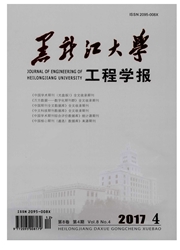

 中文摘要:
中文摘要:
A key issue of applying remotely sensed data to estimate evapotranspiration (ET) for water management is extrapolating instantaneous latent heat flux (LE) at satellite over-passing time to daily ET total. At present, the most commonly used extrapolation methods have the same assumption that evaporative fraction (EF) can be treated as constant during daytime (so-called EF self-preservation). However, large errors are reported by many documents over various ecosystems with the same approach, which indicates that further analysis of the diurnal pattern of EF is still necessary. The aim of this study is to examine the diurnal pattern of EF under fair weather conditions, then to analyze the dependencies of EF to meteorological and plant factors. Long-term flux observations at four sites over semi-arid and semi-humid climate regions in the northern China are used to analyze the EF diurnal pattern. Results show that the EF self-preservation assumption no longer holds over growing seasons of crops. However, the ratio of reference ET to available energy is almost constant during the daytime, which implies the climate factors do not have much effect on the variability of EF. The analysis of diurnal pattern of air temperature, vapor pressure deficiency (VPD), and relative humidity (RH) confirms the assumption that ET diurnal pattern is mainly influenced by stomatal regulation.
 英文摘要:
英文摘要:
A key issue of applying remotely sensed data to estimate evapotranspiration (ET) for water management is extrapolating instantaneous latent heat flux (LE) at satellite over-passing time to daily ET total. At present, the most commonly used extrapolation methods have the same assumption that evaporative fraction (EF) can be treated as constant during daytime (so-called EF self-preservation). However, large errors are reported by many documents over various ecosystems with the same approach, which indicates that further analysis of the diurnal pattern of EF is still necessary. The aim of this study is to examine the diurnal pattern of EF under fair weather conditions, then to analyze the dependencies of EF to meteorological and plant factors. Long-term flux observations at four sites over semi-arid and semi-humid climate regions in the northern China are used to analyze the EF diumal pattern. Results show that the EF self-preservation assumption no longer holds over growing seasons of crops. However, the ratio of reference ET to available energy is almost constant during the daytime, which implies the climate factors do not have much effect on the variability of EF. The analysis of diurnal pattern of air temperature, vapor pressure deficiency (VPD), and relative humidity (RH) confirms the assumption that ET diurnal pattern is mainly influenced by stomatal regulation.
 同期刊论文项目
同期刊论文项目
 同项目期刊论文
同项目期刊论文
 Calculating actual crop evapotranspiration under soil water stress conditions with appropriate numer
Calculating actual crop evapotranspiration under soil water stress conditions with appropriate numer Remote sensing temporal and spatial patterns of evapotranspiration and the responses to water manage
Remote sensing temporal and spatial patterns of evapotranspiration and the responses to water manage Estimation of evapotranspiration using a remote sensing model over agricultural land in the North Ch
Estimation of evapotranspiration using a remote sensing model over agricultural land in the North Ch Impact of Urbanization on Rainfall-Runoff Process in a City: the Flood from 8 to 9 August 2007 in Xi
Impact of Urbanization on Rainfall-Runoff Process in a City: the Flood from 8 to 9 August 2007 in Xi Development of a soil-plant-atmosphere continuum model (HDS-SPAC) based on hybrid dual-source approa
Development of a soil-plant-atmosphere continuum model (HDS-SPAC) based on hybrid dual-source approa Temporal Downscaling of Crop Coefficient and Crop Water Requirement from Growing Stage to Substage S
Temporal Downscaling of Crop Coefficient and Crop Water Requirement from Growing Stage to Substage S Detecting the effect of land-use change on streamflow, sediment and nutrient losses by distributed h
Detecting the effect of land-use change on streamflow, sediment and nutrient losses by distributed h Interannual and seasonal variability in evapotranspiration and energy partitioning over an irrigated
Interannual and seasonal variability in evapotranspiration and energy partitioning over an irrigated Assessing the impacts of climate variability and human activities on annual runoff in the Luan River
Assessing the impacts of climate variability and human activities on annual runoff in the Luan River Analysis of the Diurnal Pattern of Evaporative Fraction and Its Controlling Factors over Croplands i
Analysis of the Diurnal Pattern of Evaporative Fraction and Its Controlling Factors over Croplands i Temporal variation of over-bank flooding of Wei River and its impact on a riparian wetland in Xi'an,
Temporal variation of over-bank flooding of Wei River and its impact on a riparian wetland in Xi'an, Effects of climate variability and land-use change on stormwater runoff in Xi'an, China for the past
Effects of climate variability and land-use change on stormwater runoff in Xi'an, China for the past Combining crop coefficient of winter wheat and summer maize with remotely-sensed vegetation index fo
Combining crop coefficient of winter wheat and summer maize with remotely-sensed vegetation index fo The role of run-on for overland flow and the characteristics of runoff generation in the Loess Plate
The role of run-on for overland flow and the characteristics of runoff generation in the Loess Plate Salinity dynamics of wetland ditches receiving drainage from irrigated agricultural land in arid and
Salinity dynamics of wetland ditches receiving drainage from irrigated agricultural land in arid and Coupling land surface and crop growth models for predicting evapotranspiration and carbon exchange i
Coupling land surface and crop growth models for predicting evapotranspiration and carbon exchange i Estimating epistemic and aleatory uncertainties during hydrologic modeling: An information theoretic
Estimating epistemic and aleatory uncertainties during hydrologic modeling: An information theoretic 期刊信息
期刊信息
